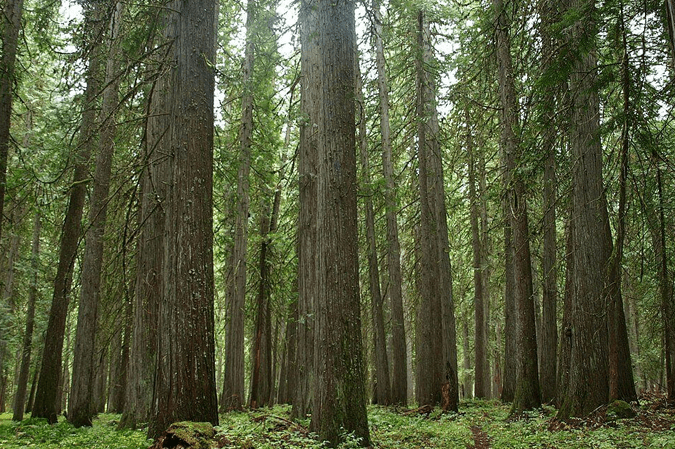Description:
The Western redcedar (Thuja plicata), also known as giant arborvitae, is an evergreen tree native to the Pacific Northwest of North America. Despite its name, the tree is not a true cedar but belongs to the cypress family (Cupressaceae). It is renowned for its immense size, often growing up to 200 feet tall with a trunk diameter of 10-13 feet, and its remarkable longevity, living for hundreds to even thousands of years. Western redcedar is characterized by its reddish-brown bark and fragrant wood.
Common Features:
- Leaves: Scale-like, arranged in flat sprays, and dark green with a glossy appearance. The foliage releases a distinct, pleasant aroma when crushed.
- Bark: Fibrous, reddish-brown, and sheds in long, thin strips.
- Cones: Small, around ½ inch long, and reddish-brown when mature, containing 8-12 scales.
- Growth: This tree thrives in moist, coastal environments and rainforests, growing in dense forests or alongside rivers and wetlands.
Role in the Ecosystem
Western redcedar plays a critical role in forest ecosystems:
- Habitat for Wildlife: The large canopies and hollowed-out trunks of old redcedars provide shelter and nesting sites for birds, small mammals, and insects. Species such as owls, bats, and squirrels often inhabit these trees.
- Soil Health and Erosion Control: The extensive root systems help stabilize the soil, preventing erosion and protecting water quality by filtering runoff near streams and rivers.
- Nutrient Cycling: Redcedar leaves decompose slowly, contributing to the nutrient-rich, acidic soils in their native habitats. Fallen leaves and wood add organic material to the forest floor, enhancing the soil’s structure and fertility.
Importance
Western redcedar has significant ecological, cultural, and economic importance:
- Indigenous Cultural Significance: Native American tribes of the Pacific Northwest consider Western redcedar a sacred tree, often referred to as the “Tree of Life.” Its wood was used to construct longhouses, canoes, totem poles, and masks. The bark was used to make clothing, ropes, and mats, and the wood was prized for its durability and resistance to decay.
- Commercial Uses: The wood of the Western redcedar is highly valued for its natural resistance to rot, insects, and weather. It is widely used for shingles, siding, decking, fencing, and outdoor furniture. The wood’s pleasant aroma also makes it popular for cedar chests and closets.
- Environmental Impact: Western redcedar trees are essential in carbon sequestration, absorbing and storing significant amounts of carbon dioxide. This makes them vital in climate regulation efforts.
Interesting Facts
- Longevity: Western redcedars can live for over 1,000 years. Some ancient specimens, like the Cheewhat Giant in British Columbia, are believed to be over 1,500 years old, making them among the oldest trees in North America.
- Aromatic Wood: The wood of the Western redcedar is naturally aromatic due to the presence of thujaplicin, a compound that also gives the tree its resistance to rot and insects.
- Medicinal Uses: Native tribes historically used the tree for medicinal purposes. The bark was often made into teas or poultices to treat colds, fevers, and rheumatism.
- Symbolism: The Western redcedar is often regarded as a symbol of strength and protection, with its wide-reaching branches and enduring wood.
Sources:
- USDA Forest Service – Western Redcedar
- The Canadian Encyclopedia – Western Redcedar
- National Park Service – Western Redcedar Ecosystem
- Image Source: www.montananaturalist.org



